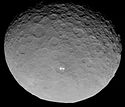Dantu (crater)
 Dantu crater. | |
| Location | Ceres |
|---|---|
| Coordinates | 24°13′N 137°26′E / 24.21°N 137.43°E[1] |
| Diameter | 124.62 kilometres (77.44 mi) |
| Naming | Dantu, the Gã god of planting |
Dantu /ˈdæntuː/ is a large crater on Ceres, located within the Vendimia Planitia. It is rimmed by a number of minor faculae, which together form Bright Spot 2.
Etymology[edit]
The crater is named after Dantu, the timekeeper and first god of planting (millet) of the Gã people of Accra, Ghana.[2]
Formation[edit]
Dantu is thought to have formed 230+30
−30 Ma (million years) ago, based on the amount of crater impacts present within its ejecta blankets.[3]
Physical features[edit]
The walls of Dantu are quite heavily eroded, with most of the north-eastern wall having collapsed completely.[3] Due to Dantu's relatively young age its crater floor is smooth, with few additional craters present within it.[3] Dantu's floor is also home to a system of fractures, which are mostly located in the south of the crater.[3]
The center of Dantu is home to a peak, with a ring complex around said peak.[4] The majority of Dantu's pit craters surround this feature, with said pit craters largely being between 400 and 900 metres in diameter.[4]
References[edit]
- ^ Staff (6 July 2015). "Planetary Names: Crater, craters: Dantu on Ceres". USGS. Retrieved 7 August 2015.
- ^ Marion Kilson (2013) Dancing with the Gods: Essays in Ga Ritual
- ^ a b c d Kallisch, J.; et al. (2017). "Geological Evolution and Composition of the Dantu Crater" (PDF). EPSC Abstracts. 11. European Planetary Science Congress: 1. Retrieved September 9, 2022.
- ^ a b Sizemore, Hanna G.; et al. (16 July 2017). "Pitted terrains on (1) Ceres and implications for shallow subsurface volatile distribution". Geophysical Research Letters. 44 (13). American Geophysical Union: 6570–6578. doi:10.1002/2017GL073970. PMC 5606497. PMID 28989206.
Further reading[edit]
- Stephan, Katrin; et al. (15 January 2019). "Spectral investigation of quadrangle AC-H 3 of the dwarf planet Ceres – The region of impact crater Dantu" (PDF). Icarus. 318. Elsevier: 111–123. doi:10.1016/j.icarus.2017.07.019. S2CID 126202699. Retrieved 2 October 2022.
- Stein, Nathan T.; et al. (1 March 2019). "The formation and evolution of bright spots on Ceres". Icarus. 320. Elsevier: 188–201. doi:10.1016/j.icarus.2017.10.014. S2CID 55621886.


